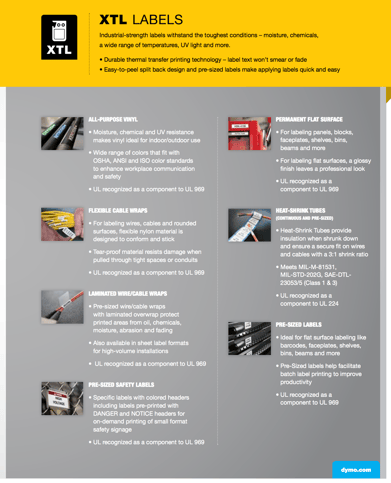This is a common question, and a GOOD one, because you only want to label something once if you can help it. Label materials vary according to jobs and applications, so here are a few general rules to consider when addressing those different needs:
 Vinyl Labels (Indoor/Outdoor Labels) are typically used where the name suggests, both indoors and out. Because it is flexible material, vinyl can be wrapped around wires, cables, posts, rails, poles and tubes. But it also works GREAT on flat surfaces. DYMO offers it in 6 widths and 13 color combinations, because it is DYMO's most popular label, and for that reason, it is known as DYMO's "fits all" go-to label.
Vinyl Labels (Indoor/Outdoor Labels) are typically used where the name suggests, both indoors and out. Because it is flexible material, vinyl can be wrapped around wires, cables, posts, rails, poles and tubes. But it also works GREAT on flat surfaces. DYMO offers it in 6 widths and 13 color combinations, because it is DYMO's most popular label, and for that reason, it is known as DYMO's "fits all" go-to label.- Polyester Labels are designed for FLAT surfaces, because polyester has "memory" and tends to assume its orginal shape after a few hours. For this reason, it is best for drawers/shelves/folders/binders/racks and other flat surfaces, but should not be used to "wrap" wires or cables. The one exception is for creating a "flag" label - which is ok because the adhesive sticks very well when bonded to itself. Polyester labels are available in "continuous" and "pre-sized" formats.
- Flexible (Nylon) material is specifically designed for wire/cable wraps, but can also be used on flat surfaces. It is very tough and tear resistant, which makes it great for wires being pulled through long sections of conduit or wood/metal framing posts.
- Heat Shrink Tubes are used to tag wires on aircraft, boats, marine equipment, solar panels, etc. where a compressed label is preferred for extra "booting" strength and to shield against water, liquids and other contaminants. Many military applications require "Mil-Spec" HST lavels for their labeling jobs. HST is available in continuous and pre-sized formats.
- Self-Laminated Wire Wrap Labels are perfect for wrapping wires and cables with a clear overlay that protects the label from damage and degradation. However, as the name suggests, they are only for wrapping around wires/cables and small posts or supports. The clear "tail" MUST be long enough to completely cover the printed surface (the "white zone") to prevent the toner from being scraped off by contact.
So - the best "all around" fits-all material is Vinyl. However, each individual installer must decide what works best for their preference and the specs of the job at hand.
Click here to see the applications of each material.



.png?width=58&height=58&name=X_logo_2023_(white).png)
